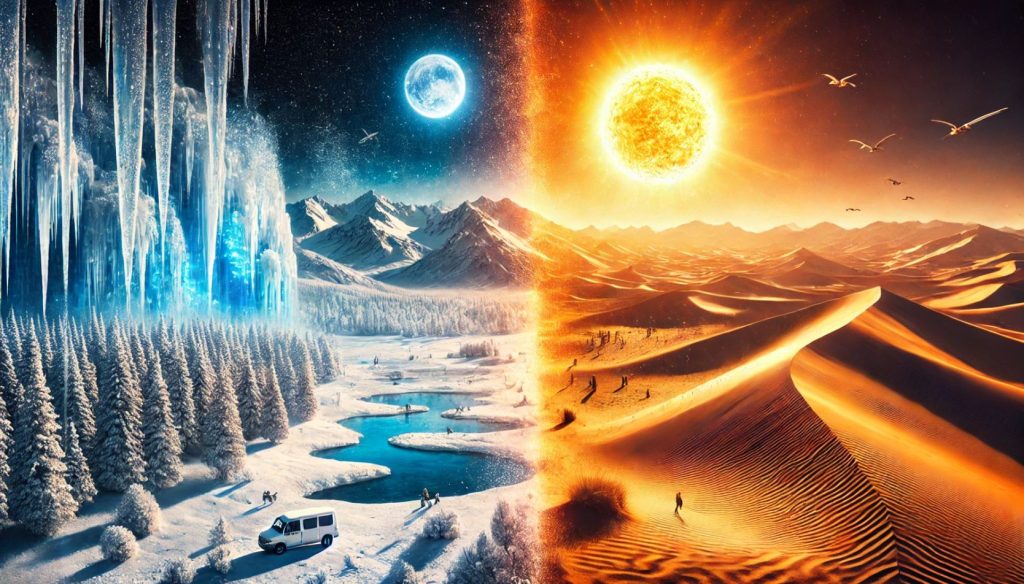Earth is home to a diverse range of climates, from freezing cold to scorching heat. While some places experience mild temperatures year-round, others push the boundaries of what we think is possible with extreme temperatures on Earth. Two extreme examples stand out: the hottest and coldest places on Earth. Let’s explore these remarkable locations that showcase the planet’s dramatic climate contrasts.
1. The Coldest Place on Earth – Vostok Station, Antarctica

Vostok Station, located in the heart of Antarctica, holds the title for the coldest place on Earth. This Russian research station, situated at an elevation of 3,488 meters (11,444 feet) above sea level, is famous for enduring some of the harshest conditions imaginable due to the extreme temperatures on Earth.
- Record Temperature: The coldest temperature ever recorded on Earth was a staggering -89.2°C (-128.6°F) on July 21, 1983. This temperature was recorded at the nearby Soviet Union’s Vostok Station.
- Why So Cold? Vostok Station lies in a high-altitude region where sunlight is sparse during the polar winter months, creating extremely cold conditions. With its isolation, limited sunlight, and dry air, this region of the Earth remains frozen year-round.
Living conditions here are unbearable without proper insulation and protection. Scientists and researchers working in Antarctica must endure extreme cold, limited daylight, and unpredictable weather patterns. Despite these challenges, research stations like Vostok play a critical role in studying climate patterns, ice cores, and other scientific phenomena.
2. The Hottest Place on Earth – Death Valley, USA

In stark contrast, Death Valley in California, USA, is home to some of the hottest temperatures ever recorded on Earth. This desert landscape is known for its blistering heat, with the temperature regularly climbing to levels that few other places can match when considering extreme temperatures on Earth.
- Record Temperature: Death Valley’s Furnace Creek holds the record for the highest air temperature ever recorded on Earth, a scorching 56.7°C (134°F) on July 10, 1913.
- Why So Hot? Death Valley’s geography plays a significant role in its extreme heat. Located below sea level, it is surrounded by mountains that trap hot air, preventing it from escaping. This creates a natural oven-like effect, amplifying the already high temperatures during the summer months. The valley’s dark-colored soil also absorbs heat, further intensifying the sweltering conditions.
Despite its extreme heat, Death Valley remains a popular destination for tourists, photographers, and researchers interested in studying the desert’s unique ecosystem and geology. The park’s stark beauty is as awe-inspiring as it is dangerous, offering an unforgettable experience to those who dare to visit these extreme temperatures on Earth.
A World of Extremes
The temperatures found in Vostok Station and Death Valley are just two examples of the vast climatic differences on our planet. These extremes not only fascinate scientists and adventurers but also challenge the adaptability of life in these environments. While some species thrive in the frigid cold of Antarctica, others survive the scorching heat of the desert. Exploring these extreme temperatures on Earth reveals how diverse life can be.
These places highlight the extremes that Earth is capable of, offering a powerful reminder of the planet’s incredible diversity and resilience. Whether it’s the freezing cold of the Antarctic or the relentless heat of the desert, Earth continues to surprise and captivate with its natural wonders.
Conclusion
From the icy plains of Antarctica to the sun-baked expanses of Death Valley, these extreme locations are reminders of the planet’s ability to support both extremes of temperature. They offer a glimpse into how diverse and powerful nature can be, showcasing the raw power of Earth’s climatic forces. Whether it’s cold or hot, these places remind us of the importance of respecting and understanding the world we live in.
This blog was written by Henify.com.




